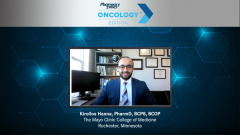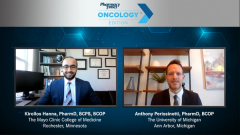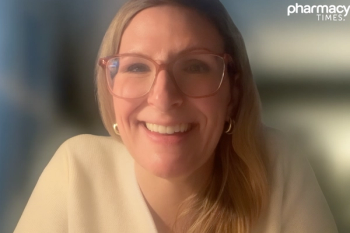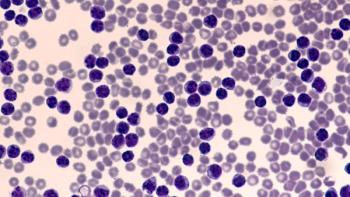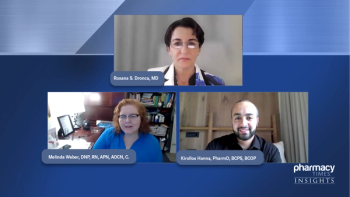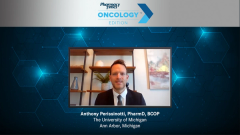
Treatment Options in Chronic Lymphocytic Leukemia
Anthony Perissinotti, PharmD, BCOP, provides an overview of the available treatment options in chronic lymphocytic leukemia, highlighting the role of first-generation BTK inhibitors.
Episodes in this series

Kirollos Hanna, PharmD, BCPS, BCOP: Hello, and welcome to this Pharmacy Times® Insights, “The Evolving Treatment Landscape in CLL, Updates From ASH 2021.” My name is Kirollos Hanna. I’m an oncology pharmacy manager at M Health Fairview in Minneapolis, Minnesota. I’m also an assistant professor of pharmacy at the Mayo Clinic College of Medicine in Rochester, Minnesota. Joining me today in this virtual discussion is Dr Anthony Perissinotti. Dr Perissinotti, could you introduce yourself to us?
Anthony Perissinotti, PharmD, BCOP: Hello, everybody. I’m Anthony Perissinotti. I’m a clinical pharmacist specialist at the University of Michigan. I take care of patients with hematologic disorders.
Kirollos Hanna, PharmD, BCPS, BCOP: Thanks so much, Dr Perissinotti. Today, we’re going to discuss the updates on novel and emerging therapies presented at the ASH, or American Society of Hematology, 2021 annual meeting. We will review the recent data on the efficacy of therapies along the disease continuum and address the management of toxicities to provide patients with optimal care, and the critical role of the pharmacist. Let’s get started.
Dr Perissinotti, I think at ASH it was a really exciting year for patients with CLL [chronic lymphocytic leukemia] and SLL [small lymphocytic lymphoma]. Not only are we trying to move the needle forward with monotherapy BTK [Bruton tyrosine kinase] inhibitors, and the extensive data that we’ve seen in long-term efficacy, we’re also looking at BCL2 inhibition, combination therapies, fixed duration, and MRD [minimal residual disease] negativity. It has been really mind-blowing. Why don’t you kick us off and give us an overview of what the available treatment options are for CLL. What is the role of first-generation BTK inhibitors in treating patients with CLL?
Anthony Perissinotti, PharmD, BCOP: I want to re-emphasize a word that you said, and that’s mind-blowing. Things have escalated quickly in CLL. Over the last decade, we’ve moved away from cytotoxic chemotherapy to primarily only using 2 strategies: either a BTK inhibitor or venetoclax with obinutuzumab. And those 2 paradigms are a little different in that our BTK inhibitors, we’re using them indefinitely until progression or intolerance. Patients take a pill or two a day indefinitely, whereas with venetoclax-based regimens, we’re giving them for a year, and then we’re stopping therapy. So, this is in deep contrast to how we used to give cytotoxic chemotherapy. Patients would get about 6 cycles of chemotherapy, they’d have quite a bit of toxicity up front, and then over time, they’d still have to worry about long-term toxicities. One of the most feared was secondary malignancies. Chemotherapy is still an option inside of the NCCN [National Comprehensive Cancer Network guidelines], especially if you have immunoglobulin heavy chain mutations, just because those patients can have very durable outcomes. However, when you’re sitting in front of a patient, it is a tough sell to talk to them about the acute and long-term toxicities associated with FCR [fludarabine, cyclophosphamide, rituximab] in chemotherapy. So I’m simplifying the treatment paradigm as either using a BTK inhibitor or a venetoclax-based regimen.
That’s also true in the second-line setting. Again, to keep it simple: either a BTK inhibitor or a venetoclax-based regimen. At the end of this presentation, we’ll go into the nuances of how we select therapies in the front line and the second line, and we’ll talk about how perhaps maybe some ASH data have changed things. But long story short: a venetoclax-based regimen or BTK inhibitor. When you’re choosing a BTK inhibitor, however, you also have multiple selections, as you alluded to, Dr Hanna. You’ve got your first-generation ibrutinib, and we have data from ASH from the RESONATE-2 trial that show with 7 years of follow-up that about 60% of patients are still on therapy, and they’re still progression free. These patients are on therapy for nearly almost a decade now. So, those are really fantastic results from that perspective.
Transcript edited for clarity.
Newsletter
Stay informed on drug updates, treatment guidelines, and pharmacy practice trends—subscribe to Pharmacy Times for weekly clinical insights.

